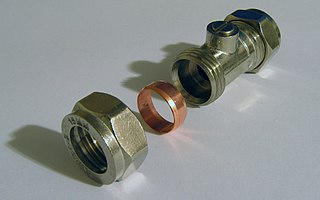History
British manufacturer Hepworth Building Products (founded 1936 in Doncaster) introduced these fittings under the brand Hep2O in 1980. It was a grey plastic material for the first couple of decades. There was a reusable fitting that could be unscrewed and a slimmer single-use fitting which could not. A new grab washer was required each time if a joint was reused. The fittings were designed for use with polybutylene pipe, while stainless steel pipe inserts were used for internal support.
Hepworth was acquired by Wavin in 2005. [1] Hep2O changed material and design in the 2000s to a smooth white plastic and a push-to-demount design. This resulted in a physically smaller fitting that is easier to release, especially in a confined space.
John Guest (Established in 1961, West Drayton, UK) developed the Speedfit push-fit connector for compressed air use in 1974, and introduced plumbing fittings in 1987. [2] These fittings are white plastic, and are unscrewable to replace components, like Hep2O, but also have a push-release mechanism. Speedfit uses plastic pipe support inserts.
Brass demountable push-fit fittings are manufactured by Pegler under the brand Tectite. In the US, several different brands are available: Sharkbite, PlumBite, Nibco Push, which are all brass, demountable, similar to the Pegler Tectite design.
Some fittings are only designed for plastic (PEX and PERT) pipe and are non-removable. In the US, Legend Valve make a single-use push-fit system, and Sharkbite have one called EvoPex.
Usage
Push fit connections are easier to make than soldered or glued connections, however there is still some knowledge needed to do it right. The defects that can cause joint failure are not pushing the pipe in far enough, not having a smooth round end to the pipe, too rough a pipe surface under the O-ring, and detritus in the mechanism.
Deburring the end of the pipe is vital to avoid damaging the O-ring on insertion, and the pipe surface under the ring must be smooth to get an adequate seal. The pipe end should be square so it sits against the stop in the fitting and does not cause turbulence in the flow of water.
It is quite easy to push the pipe in only as far as the grab ring, or the O-ring, and not all the way to the stop. This is the most common issue with inexperienced use of these connectors. Fitting designers have come up with a selection of methods to try and show the user when they have pushed it in far enough. Pipes are often marked to show the insertion depth, so if you cut at a mark, then insert the pipe up to the next mark, you will have a good connection. Hepworth pipe has always had this feature, for example. Making a mark before insertion is advised on pipe that is not pre-marked (e.g. copper pipe). Hepworth supply an insert with bulges on the end. When fully inserted this lines up with bulges in the fitting so that if you rotate the pipe in the fitting it "rumbles". Manufacturers of non-removable PEX/PERT fittings have included a coloured indicator ring which is pushed into a visible place on full insertion, or a spring-clip separator which is pushed out by the pipe so there is an audible "snap".

Plumbing is any system that conveys fluids for a wide range of applications. Plumbing uses pipes, valves, plumbing fixtures, tanks, and other apparatuses to convey fluids. Heating and cooling (HVAC), waste removal, and potable water delivery are among the most common uses for plumbing, but it is not limited to these applications. The word derives from the Latin for lead, plumbum, as the first effective pipes used in the Roman era were lead pipes.

Components of an electrical circuit are electrically connected if an electric current can run between them through an electrical conductor. An electrical connector is an electromechanical device used to create an electrical connection between parts of an electrical circuit, or between different electrical circuits, thereby joining them into a larger circuit. Most electrical connectors have a gender – i.e. the male component, called a plug, connects to the female component, or socket. The connection may be removable, require a tool for assembly and removal, or serve as a permanent electrical joint between two points. An adapter can be used to join dissimilar connectors.

Zero insertion force (ZIF) is a type of IC socket or electrical connector that requires very little force for insertion. With a ZIF socket, before the IC is inserted, a lever or slider on the side of the socket is moved, pushing all the sprung contacts apart so that the IC can be inserted with very little force - generally the weight of the IC itself is sufficient and no external downward force is required. The lever is then moved back, allowing the contacts to close and grip the pins of the IC. ZIF sockets are much more expensive than standard IC sockets and also tend to take up a larger board area due to the space taken up by the lever mechanism. Typically, they are only used when there is a good reason to do so.
A solder ring fitting, also known by the trademarked name Yorkshire fitting, is a pre-soldered capillary connector for joining copper pipes used in plumbing.

An edge connector is the portion of a printed circuit board (PCB) consisting of traces leading to the edge of the board that are intended to plug into a matching socket. The edge connector is a money-saving device because it only requires a single discrete female connector, and they also tend to be fairly robust and durable. They are commonly used in computers for expansion slots for peripheral cards, such as PCI, PCI Express, and AGP cards.

In computer hardware, a CPU socket or CPU slot contains one or more mechanical components providing mechanical and electrical connections between a microprocessor and a printed circuit board (PCB). This allows for placing and replacing the central processing unit (CPU) without soldering.

Wavin B.V. is a global manufacturer of plastic pipes, mainly for drainage and water supply purposes. The company was officially founded in the Netherlands on 5 August 1955, its name deriving from water and vinyl chloride. The company provides plastic pipe systems and products for tap water, surface heating and cooling, soil and waste, rain water, distribution of drinking water and gas and telecom applications.

A compression fitting is a fitting used in plumbing and electrical conduit systems to join two tubes or thin-walled pipes together. In instances where two pipes made of dissimilar materials are to be joined, the fittings will be made of one or more compatible materials appropriate for the connection. Compression fittings for attaching tubing (piping) commonly have ferrules in them, and are sometimes referred to as flareless fittings. There are also flare fittings that do not require ferrules/olives.
Cross-linked polyethylene, commonly abbreviated PEX, XPE or XLPE, is a form of polyethylene with cross-links. It is used predominantly in building services pipework systems, hydronic radiant heating and cooling systems, domestic water piping, insulation for high tension electrical cables, and baby play mats. It is also used for natural gas and offshore oil applications, chemical transportation, and transportation of sewage and slurries. PEX is an alternative to polyvinyl chloride (PVC), chlorinated polyvinyl chloride (CPVC) or copper tubing for use as residential water pipes.

A garden hose, hosepipe, or simply hose is a flexible tube used to convey water. There are a number of common attachments available for the end of the hose, such as sprayers and sprinklers. Hoses are usually attached to a hose spigot or tap.

A pipe is a tubular section or hollow cylinder, usually but not necessarily of circular cross-section, used mainly to convey substances which can flow — liquids and gases (fluids), slurries, powders and masses of small solids. It can also be used for structural applications; hollow pipe is far stiffer per unit weight than solid members.

A fitting or adapter is used in pipe systems to connect straight sections of pipe or tube, adapt to different sizes or shapes, and for other purposes such as regulating fluid flow. These fittings are used in plumbing to manipulate the conveyance of water, gas, or liquid waste in domestic or commercial environments, within a system of pipes or tubes.

Ground glass joints are used in laboratories to quickly and easily fit leak-tight apparatus together from interchangeable commonly available parts. For example, a round bottom flask, Liebig condenser, and oil bubbler with ground glass joints may be rapidly fitted together to reflux a reaction mixture. This is a large improvement compared with older methods of custom-made glassware, which was time-consuming and expensive, or the use of less chemical resistant and heat resistant corks or rubber bungs and glass tubes as joints, which took time to prepare as well.

A screw terminal is a type of electrical connection where a wire is held by the tightening of a screw.

Plastic pipe is a tubular section, or hollow cylinder, made of plastic. It is usually, but not necessarily, of circular cross-section, used mainly to convey substances which can flow—liquids and gases (fluids), slurries, powders and masses of small solids. It can also be used for structural applications; hollow pipes are far stiffer per unit weight than solid members.

Viega is a family owned international manufacturer of Plumbing and HVAC solutions. Viega sells PEX for Radiant heating and plumbing systems along with copper, stainless, and metal alloy pipe along with mechanical pressure fitting products.

Soldering is a process of joining two metal surfaces together using a filler metal called solder. The soldering process involves heating the surfaces to be joined and melting the solder, which is then allowed to cool and solidify, creating a strong and durable joint.

Copper tubing is most often used for heating systems and as a refrigerant line in HVAC systems. Copper tubing is slowly being replaced by PEX tubing in hot and cold water applications. There are two basic types of copper tubing, soft copper and rigid copper. Copper tubing is joined using flare connection, compression connection, pressed connection, or solder. Copper offers a high level of corrosion resistance but is becoming very costly.
John Guest is a British manufacturer of push-in fittings, pipe and plastic plumbing systems. Its industries and applications include drink dispensing, plumbing, pneumatics, compressed air Systems, water purification, drinks vending, automotive and telecommunications.

The Parflange F37 system is a technology from the hydraulic area of Parker-Hannifin, which allows a non welded flange connection of hydraulic tubes and pipes.

















